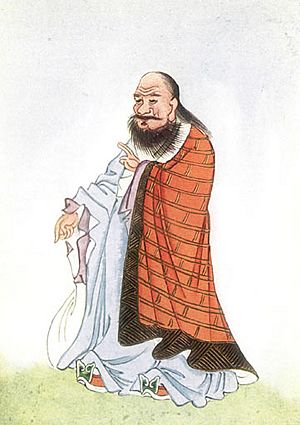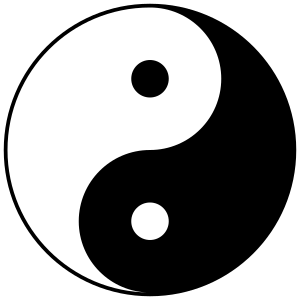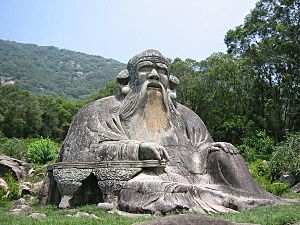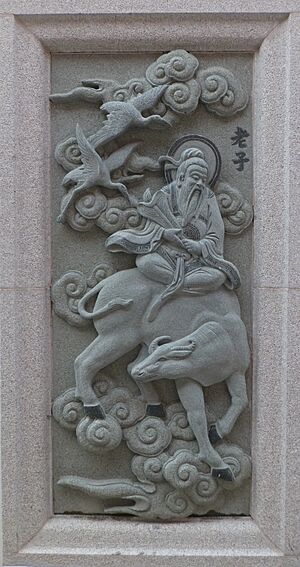Laozi facts for kids
Quick facts for kids
Laozi
老子 |
|
|---|---|
 |
|
| Born | Unknown, 6th century – 4th century BC Chujen village, state of Chu
|
| Died | Unknown, 6th century – 4th century BC |
| Era | Ancient philosophy |
| Region | Chinese philosophy |
| School | Taoism |
|
Notable ideas
|
Tao, wu wei |
|
Influenced
|
|
Laozi (also spelled Lao Tsu or Lao-Tze) was a famous Chinese philosopher. He is best known for starting Taoism, a way of thinking and living. He also wrote an important book called the Daodejing. Some people even believe he became a god in Taoism and Chinese folk religions. Laozi was a legendary figure in Chinese culture. He might have lived during the Warring States period, a time of many battles in ancient China. His ideas influenced thinkers who believed in less government power.
Contents
What was Laozi's Real Name?
Laozi's real name was supposedly Li Er (李尔). His special adult name, called a courtesy name, was Boyang (伯阳). A popular name given to him after his death was Li Dan (李聃). During the Tang Dynasty, a powerful time in Chinese history, he was called the "Supremely Mysterious and Primordial Emperor."
Many families named Li say they are related to Laozi. For example, the emperors of the Tang Dynasty claimed he was their ancestor. This shows how important Laozi was to Chinese culture and history.
Who Was Laozi?
Was Laozi a Real Person?
Some thinkers wonder if Laozi was a real person. They believe the Daodejing might be a collection of wise sayings from many different Taoist writers.
The first mention of Laozi is in a famous history book called "Records of the Grand Historian" by Sima Qian. One story says he was a government official who lived around the same time as Confucius. He was named "Er Li" or "Dan Li." He wrote a book with two parts before traveling west. Another story says he was named "Lao Laizi" and wrote a book with 15 parts. A third story describes him as a royal astrologer named "Lao Dan." The oldest parts of the Daodejing were written around 375 BCE.
Traditional stories say Laozi worked as a librarian for the Zhou Dynasty. This job allowed him to read many old books and learn a lot. Laozi never opened a school, but he still had many students. There is a famous story about him meeting Confucius, another great Chinese philosopher.
Laozi's Birth Story
Laozi may have been born in the village of Chu Jen in the state of Chu.
Taoist myths tell a magical story about Laozi's birth. They say he was born after his mother saw a falling star. He stayed in her womb for 62 years while she leaned against a plum tree. The Chinese word for "plum" is Li (李), which is also Laozi's family name. It is said that Laozi was born as a grown man with a full grey beard and long ears. These features were symbols of great wisdom and a long life. Other myths say he was reborn 13 times before his life as Laozi. In his last life as Laozi, he lived for 999 years. He spent his life traveling and sharing the Tao (the Way).
The Story of Laozi's Son, Zong
Some stories say Laozi was married and had a son named Zong. They were separated when Zong was a child. Zong grew up to be a famous soldier who won many battles. Later, Zong learned that Laozi, who was teaching about the Dao, was his father. Laozi taught Zong that it is better to treat defeated enemies with respect. He said that disrespecting the dead would make enemies want revenge. So, Zong ordered his soldiers to bury the enemy dead and hold funerals for them. This act led to lasting peace.
Laozi and the Buddha
Sima Qian wrote that Laozi grew tired of the moral problems in Chengzhou. The kingdom was becoming weaker. So, he traveled west and lived near the border until he was 80 years old. A guard named Yinxi recognized him at a western gate. Yinxi asked Laozi to write down his wisdom. This writing became the Daodejing. However, the book we have today includes parts added later. In some versions of the story, Yinxi loved the book so much that he became Laozi's student. They left together and were never seen again. Other stories say the "Old Master" traveled all the way to India. They even say he was the teacher of Siddhartha Gautama, the Buddha himself! Some even believe Laozi was the Buddha.
A book from the seventh century, the Sandong Zhunang, says Laozi pretended to be a farmer when he reached the western gate. But Yinxi recognized him and asked to be taught by the great master. Yinxi wanted to find the Tao and said his long study of the stars helped him recognize Laozi. Laozi accepted Yinxi as a student. This story shows that a person seeking wisdom might be tested before being accepted by a master.
Yinxi then trained hard. After his training, the two traveled to the western lands. They reached a very high religious rank in Taoism. Laozi is seen as the perfect Taoist master, and Yinxi is the perfect student. Laozi is like the Tao in human form, teaching others how to find salvation.
The stories about Laozi became more religious after the Han dynasty. As Taoism grew, people began to worship Laozi as a god. The Way of the Celestial Masters was the first Taoist group. Later Taoists believed Laozi was the Dao (the Way) in human form. Religious Taoism says that Laozi did not disappear after writing the Daodejing. Instead, he spent his whole life traveling and showing the Dao to others.
What is Taoism?
Laozi is traditionally seen as the person who started Taoism. In popular Taoism, the Jade Emperor is often seen as the main god. However, intellectual Taoists, like the Celestial Masters sect, usually see Laozi (called Laojun, or "Lord Lao") and the Three Pure Ones as the main gods.
The Daodejing

Laozi is traditionally believed to be the author of the Daodejing. However, some people disagree with this idea. It is one of the most important books in Chinese thought about how the universe began. Like other ancient Chinese philosophers, Laozi often explains his ideas using riddles, comparisons, old sayings, and rhymes. The whole book can be seen as a big comparison: the ruler is like a person's self, and the empire is like their body, senses, and desires.
The Daodejing says the Dao is the source and perfect example of everything that exists. It is unseen and very powerful, but also very humble. It is the root of all things. People have desires and free will. Many act "unnaturally," which breaks the natural balance of the Dao. The Daodejing wants to help people "return" to their natural state, living in harmony with the Tao. Taoism believes that language can be misleading. It shows this through its riddles.
For example, technology might make us feel like we are always making progress, but this feeling can be false. Laozi says we should not reject technology. Instead, we should seek a calm state called wu wei (無爲). This means living without too many desires. Laozi also suggests that rulers should keep their people simple-minded. This could be advice for how to rule, or it could be a religious idea. The book uses terms like "valley spirit" and "soul."
Wu wei literally means "non-action" or "not acting." It is a very important idea. This concept has many meanings. It can mean "not doing anything," "not forcing things," "acting without effort," or "flowing with the moment."
It helps explain ziran (自然), which means being in harmony with the Tao. It says that all ambition comes from the same place. Laozi used wu wei to mean simplicity and humility are important qualities. These are different from being selfish. In politics, wu wei means avoiding war, harsh laws, and high taxes. Some Taoists connect wu wei with special practices like zuowang (坐忘), which means "sitting in oblivion" or emptying the mind of thoughts. This idea is found in the Zhuangzi.
How Laozi Influenced Ideas About Government
Laozi and Zhuangzi influenced many people throughout Chinese history. Zhuangzi was Laozi's most famous follower. Zhuangzi greatly influenced Chinese scholars, government workers, and culture. Politicians sometimes used Laozi's ideas to avoid serving their rulers. They valued humility in leaders and believed in a government with limited power. They did this either because they truly believed it or for their own political reasons. Some groups who opposed strong authority used Laozi's teachings to show the power of the weak.
Laozi supported the idea of a limited government. People who believe in left-libertarianism have been influenced by Laozi. In his 1937 book, Nationalism and Culture, the anarcho-syndicalist writer Rudolf Rocker praised Laozi's "gentle wisdom." He understood that sometimes political power worked against culture and the community. In his 1910 article for the Encyclopædia Britannica, Peter Kropotkin said Laozi was one of the first people to support anarchism. Many anarchists, like Ursula K. Le Guin, have used Laozi's ideas to support their beliefs. Le Guin wrote that Laozi "does not see political power as magic. He sees rightful power as earned and wrongful power as taken... He sees sacrificing oneself or others as a bad use of power. He believes power is available to anyone who follows the Way. No wonder anarchists and Taoists get along well."
Economist Murray Rothbard suggested that Laozi was the first libertarian. He compared Laozi's ideas to Friedrich Hayek's idea of spontaneous order, where things organize themselves naturally. James A. Dorn agreed, saying that Laozi, like many liberals, "argued that making the government smaller and letting people develop naturally would best create social and economic harmony." David Boaz quotes the Daodejing in his 1997 book The Libertarian Reader. Philosopher Roderick Long argues that libertarian ideas in Taoism actually came from earlier Confucian writers.
Images for kids
-
According to Chinese legend, Laozi left China for the west on a water buffalo.
-
Confucius meets Laozi, Shih Kang, Yuan dynasty
-
A Western Han (202 BCE – 9 CE) fresco showing Confucius and Laozi, from a tomb in Dongping County, Shandong, China
See also
 In Spanish: Lao-Tse para niños
In Spanish: Lao-Tse para niños








